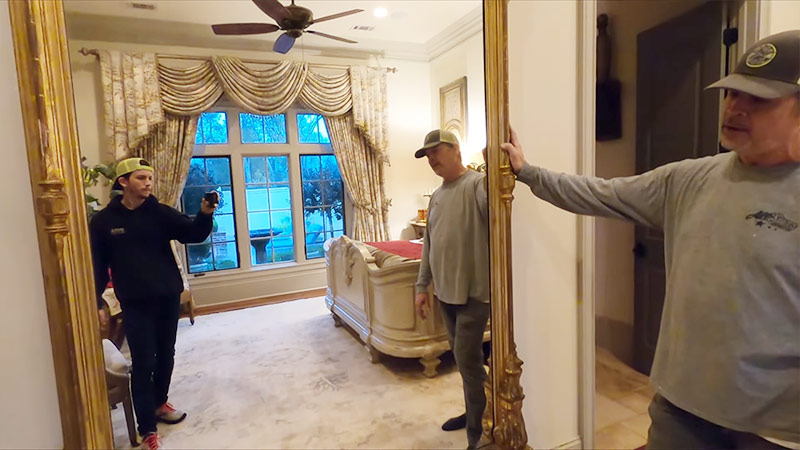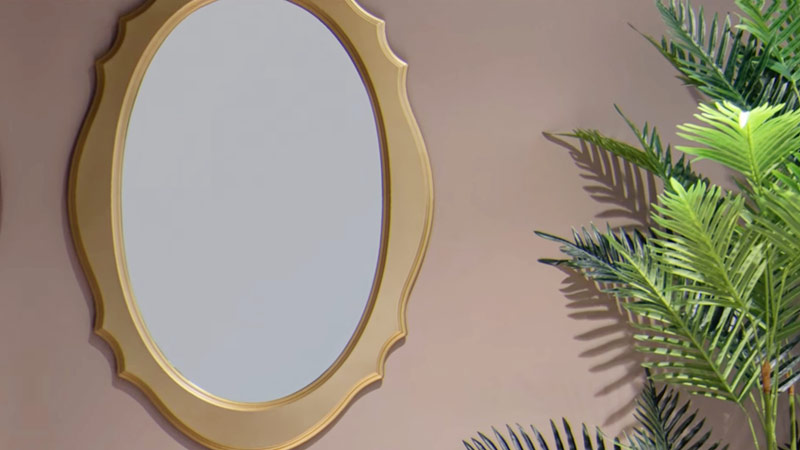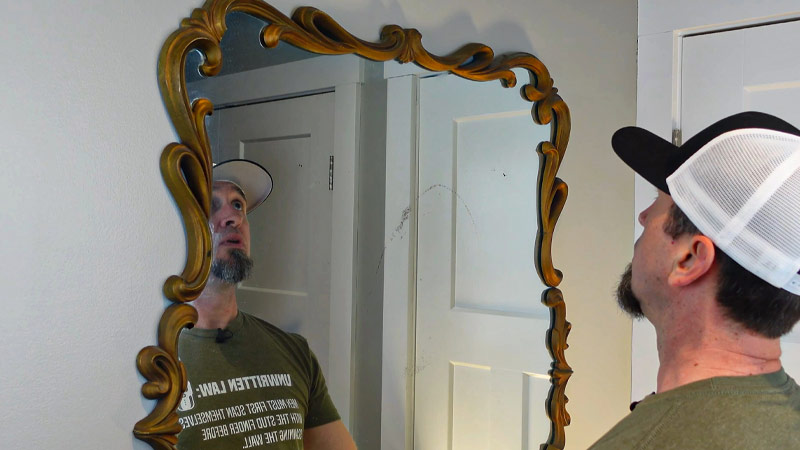Old mirrors are often perceived to be heavy due to their antique status and the materials used to create them. Many antique mirrors were made using heavy materials such as silver or mercury, which contributed to their weight.
In addition, the size and thickness of antique mirrors may be larger than those of modern mirrors, further adding to their weight.
The weight of an antique mirror can give it a sense of quality and durability, but it can also present challenges when it comes to handling and hanging the mirror.
Despite these challenges, many people appreciate the aesthetic and historical value of antique mirrors and are willing to overlook their weight in favor of their unique character and charm.

Materials Used in the Production of Mirrors
Mirrors are commonly made using the following materials:
Glass
The most common material for mirror production is glass. Specifically, flat glass with a smooth and polished surface is used. Glass mirrors provide a clear and reflective surface.
Reflective Coating
To create the reflective surface of the mirror, a thin layer of metal is applied to the back of the glass.
In the past, silver was commonly used, but nowadays, aluminum is often preferred due to its lower cost and comparable reflectivity. Sometimes, other metals like copper or gold may be used for decorative or specialized mirrors.
Protective Coating
To protect the reflective layer and prevent it from tarnishing or corroding, a layer of clear protective coating is often applied on top. This coating also helps improve the mirror’s durability.
Backing Material
Mirrors are often mounted on a backing material, which can be made of various materials like plywood, medium-density fiberboard (MDF), or plastic. The backing material provides support and rigidity to the mirror.
Frame Material
Many mirrors are encased in frames for both functional and aesthetic purposes.
Frames can be made from a wide range of materials, including wood, metal, plastic, and even more unconventional materials like seashells or mosaic tiles, depending on the design and style of the mirror.
Adhesive
An adhesive or backing paint is used to bond the reflective coating to the glass. It ensures that the reflective layer remains securely attached to the glass surface.
These materials are combined to create a reflective surface that allows us to see our own reflection when light bounces off it. The choice of materials can vary based on the intended use and design of the mirror.
Why Are Old Mirrors So Heavy?

Old mirrors are often significantly heavier than modern mirrors for several reasons.
Firstly, the glass used in older mirrors tends to be thicker and denser. This is because older manufacturing techniques didn’t produce the same lightweight glass we have today.
Additionally, the reflective coating on old mirrors, typically made of silver, was applied to the back of the glass, adding to its weight.
In contrast, contemporary mirrors often use thinner glass, lighter materials for frames, and more efficient hanging mechanisms, making them much lighter and easier to handle.
Antique mirrors are often heavier than their modern counterparts due to several contributing factors:
Glass Thickness
Older manufacturing techniques produced thicker glass. Antique mirrors tend to have thicker glass, which adds to their weight compared to the thinner glass used in modern mirrors.
Reflective Coating
Antique mirrors typically use a reflective coating made of silver, which is applied to the back of the glass. Silver is denser and heavier than the aluminum coating commonly used in modern mirrors.
Frame Material
Antique mirrors often feature ornate and elaborate frames made from dense materials like solid wood, metal, or plaster. These heavy frames significantly contribute to the overall weight of the mirror.
Mounting Hardware
Older mirrors may have heavy-duty mounting systems, such as wires, brackets, or hooks, designed to support the mirror’s weight securely on walls. These hardware components add extra weight.
Backboard
Antique mirrors may have a substantial backboard or backing material, such as thick wood or even multiple layers of materials, to provide stability and support. This adds to the mirror’s overall weight.
Age and Wear
Over time, mirrors can accumulate dust, grime, and oxidation on their surfaces, which can add some weight. Additionally, the aging process may cause the materials to become denser or more brittle.
Size and Shape
Larger antique mirrors naturally weigh more than smaller ones due to the increased surface area of glass and potentially larger frames.
It’s important to handle antique mirrors with care due to their weight and often fragile nature.
When moving or hanging antique mirrors, it’s advisable to seek assistance and use appropriate hardware and wall anchors to ensure they are safely secured.
How Are Mirrors Made?

Mirrors are made through a process called “silvering” or “mirror-silvering,” which involves several key steps:
Glass Selection
The first step in making a mirror is to select a sheet of flat glass. This glass is typically made with precise flatness and smoothness to ensure a clear reflection.
Cleaning and Smoothing
The glass sheet is thoroughly cleaned and polished to remove any imperfections, dirt, or oils from the surface. It needs to be perfectly smooth to achieve a clear reflection.
Reflective Coating
A thin layer of reflective metal, such as aluminum or silver, is applied to the back (the reverse side) of the glass.
In the past, silver was commonly used, but aluminum is more common today due to cost and availability. This metal coating is what makes the mirror reflective.
Protective Coating
To prevent the reflective layer from tarnishing or corroding, a protective layer, often made of paint or a clear coating, is applied over the metal layer. This also adds durability to the mirror.
Drying and Curing
The mirror is allowed to dry and cure to ensure that the reflective and protective coatings adhere securely to the glass.
Quality Inspection
The mirror undergoes a quality control process to check for any imperfections, such as bubbles or defects in the reflective coating. Any flawed mirrors are discarded.
Cutting and Framing
The finished mirror may be cut into various shapes and sizes and framed using materials like wood, metal, or plastic to protect the edges and add aesthetic appeal.
The result is a mirror with a reflective surface on one side that allows light to bounce off it, creating a clear reflection of objects in front of it.
The choice of materials and the precision of the manufacturing process determine the quality and clarity of the mirror’s reflection.
Modern technology has made it possible to produce high-quality mirrors with exceptional clarity and durability.
The Benefits of Heavy Mirrors

Using heavy mirrors in your home can offer several benefits, beyond just their aesthetic appeal. Here are six key advantages of using heavy mirrors:
Enhanced Interior Design
Heavy mirrors can significantly elevate the interior design of a space. Their substantial weight and size can make a statement, becoming a focal point in a room.
They add a sense of elegance and sophistication to any decor style, from modern to classic.
Illusion of Space
Mirrors, especially large and heavy ones, create an illusion of more space in a room. When strategically placed, they reflect light and the surroundings, making the area appear larger and more open.
This is particularly beneficial in smaller rooms or areas with limited natural light.
Natural Light Amplification
Heavy mirrors positioned to capture natural light can amplify it throughout the room. This not only brightens the space but also reduces the need for artificial lighting during the day, which can result in energy savings.
Artistic Statement
Heavy mirrors often feature ornate frames or unique designs that can serve as artistic elements in your decor. They can add character and personality to a room, complementing the overall theme and style.
Practical Use
Besides their aesthetic and spatial benefits, heavy mirrors serve practical purposes.
They allow you to check your appearance and outfits before leaving the house, making them ideal for entryways, bedrooms, or walk-in closets.
Improved Room Functionality
Mirrors can be strategically placed to serve functional purposes. For example, a large mirror in a home gym can help you monitor your form while exercising.
In a dining room, a heavy mirror can create an attractive backdrop for a buffet or bar area.
Incorporating heavy mirrors into your home decor can be a smart and stylish choice, offering both aesthetic and functional advantages.
Their ability to enhance interior design, create a sense of space, and contribute to the overall ambiance of a room makes them a valuable addition to any home.
The Drawbacks of Heavy Mirrors
One drawback of heavy mirrors is that they can be challenging to hang and handle. The weight of a mirror can make it difficult to lift and position, and it may require more than one person to hang it safely.
In addition, the weight of a heavy mirror can put extra strain on the wall and mounting hardware, increasing the risk of damage to the wall or the mirror itself. It may also be more difficult to adjust the position of a heavy mirror once it is hung, as it may require more force to move.
Another drawback of heavy mirrors is that they may not be practical for certain uses or settings. For example, a heavy mirror may not be suitable for a small or poorly constructed wall, or for a location where the mirror may need to be frequently moved or repositioned.
The weight of a heavy mirror may also make it less suitable for use in a portable or mobile setting, such as a travel trailer or a pop-up shop.
Overall, while the weight of an antique mirror may contribute to its stability and durability, it can also present challenges when it comes to hanging and handling the mirror and may make it less practical for certain uses or settings.
Antique Mirror Comparison Table
| Characteristic | Mercury Mirrors | Silver Mirrors | Aluminum Mirrors |
|---|---|---|---|
| Density | High | High | Low |
| Reflectivity | High | High | Moderate |
| Durability | Moderate | High | High |
| Weight | Heavy | Heavy | Light |
| Cost | Moderate | High | Low |
| Environmental Impact | High | Low | Low |
FAQs
Yes, it is possible to re-silver an antique mirror by applying a new layer of silver to the back of the mirror. This process can restore the reflective properties of the mirror and improve its appearance.
Yes, antique mirrors can be cleaned and polished to remove dirt and tarnish. However, it is important to use gentle cleaning products and techniques to avoid damaging the mirror.
Yes, in some cases it is possible to repair antique mirrors if they are damaged. The specific repair method will depend on the nature of the damage and the materials used to make the mirror.
The invention of mirrors dates back to ancient times. The earliest known mirrors were made of polished obsidian in Mesopotamia around 6000 BCE. Metal-coated glass mirrors were developed by the Romans in the 1st century CE, advancing mirror technology.
Yes, antique mirrors can be hung in a bathroom, but it is important to consider the humidity and moisture levels in the bathroom, as these factors can affect the condition of the mirror. It may be necessary to use special mounting hardware or protective coatings to prevent damage to the mirror in a bathroom environment.
Conclusion
The weight of an antique mirror is a result of the materials used to make it, as well as the size and thickness of the mirror. Materials such as mercury and silver, which are denser than aluminum, are more likely to contribute to the weight of an antique mirror.
The weight of an antique mirror can contribute to its stability, durability, and sense of quality, but it can also present challenges when it comes to hanging and handling the mirror and may make it less practical for certain uses or settings.
While the weight of an antique mirror may be a trade-off for some, the unique character and charm of these mirrors can make them worth the extra effort for others.
Leave a Reply